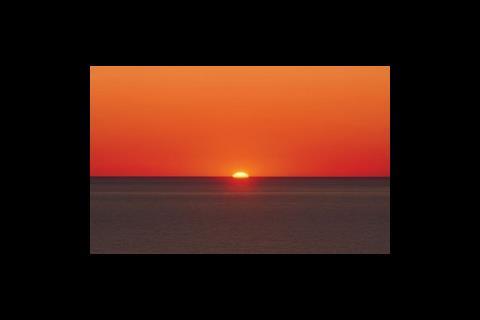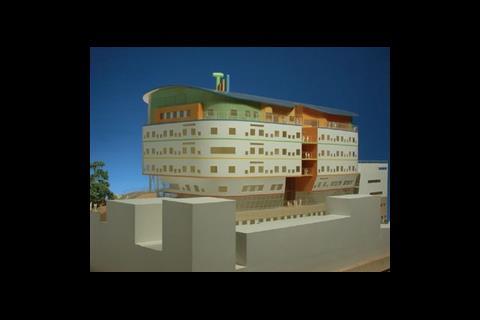The discovery of a third type of photoreceptor in the eye has led to a UK team developing a new type of lighting that could boost workers' productivity and aid patients' recovery.
How do blind people keep their body clocks synchronised with the normal cycle of day and night? It's a question that David Berson, associate professor of neuroscience at Brown University in the US, asked himself many times - and the answer could be about to revolutionise the way we light buildings.
For over 150 years, scientists believed they understood the mechanism of sight. Rods and cones were first discovered in 1722 and assumed to be the eye's only photoreceptors (cells that turn light energy into electrical impulses). Many cells in the eye and brain respond to light, but only because they are linked to rods and cones by complex pathways. These cells are responsible for the nervous system's sensitivity to patterns, objects and movements in the visual world.
However, Berson and his colleagues were baffled by how blind people - whose rods and cones don't work - can still adjust their biological rhythms to match day and night. The answer came in 2002, when the team discovered a third type of photoreceptor in the retina. Dubbed the ‘intrinsically photosensitive ganglion cell', it works by turning light energy directly into brain signals without passing through the eye's rods and cones.
According to Berson, this group of cells provides a vital role in setting the circadian rhythm (or biological clock), as well as other functions where all the brain needs to know is how bright it is. "It's a visual system that runs parallel to the one we have been thinking about all these years. Now we have to rethink how the retina works and how the brain understands what is going on in the visual world," he says. "This is a new kind of representation of light by the nervous system; a new way for the brain to react to the visual environment."
Understanding circadian rhythms
Circadian rhythms can be seen as the natural light/dark cycles that synchronise the internal human body clock with the external daily cycle. In sighted, healthy humans, these daily oscillations in neural activity are controlled by a master biological clock located in the suprachiasmatic nucleus (SCN) of the hypothalamus at the base of the brain. The non-visual photosensitive retinal ganglion cells connect directly to this, where they influence the production of melatonin by the pineal gland.
This is significant because melatonin (also known as the sleep hormone) is vital for controlling the body's sleep pattern - you need high levels of melatonin when it's time to sleep and lower levels during the day to keep you awake. This chemical is absorbed into the bloodstream, transmitted around the body and basically acts as the messenger of time.
The human circadian system, like the visual system, starts with the eye - experiments have shown that the removal of the eye eliminates all circadian response. Light entering the retina essentially travels a different route to that going to the visual cortex and arrives at the pineal gland which synthesises and releases the chemical melatonin in the absence of light.
Back in the UK, this discovery didn't go unnoticed by Martin Lupton and Laura Bayliss at BDP Lighting. "The use of light therapy to regulate the body's production of melatonin and overcome seasonal affective disorder is quite common, but up until this research, there was no hard scientific evidence as to why this was," says Lupton.
The intensity of light required to suppress melatonin production is high, but light levels in modern offices and retail environments only provide minimal stimulation to the circadian system. Working outdoors provides daily exposure levels of around 80,000 lux-hours; however, most office workers are lucky if they get 13,500. Based on these figures, natural circadian rhythms can become out of sync, affecting sleep patterns and general wellbeing. According to Lupton, "We could just try and replace the intensity of daylight with the intensity of artificial light, but to me that is a completely unsustainable approach. The answer is to try and design more natural light into buildings."
Lupton has aimed to do just that in one of BDP's recent projects: The Royal Alexander Children's Hospital in Brighton, a 100-bed hospital a few streets back from the beach. BDP provided architectural as well as multidisciplinary design for the project, which gave Lupton the opportunity to influence the daylight design.
As the most patient-centred space within the hospital, this has focused heavily on the ward areas, which are a mix of single-bed rooms and four-bed bays. "We found, when we were looking back to the codes again, that there wasn't really any sort of strict guidelines as to what the daylight factors for hospitals should be," says Lupton. "There are the usual ambiguous statements, such as ‘5% is well daylit, less than 2% will not be perceived as good.' It just leaves it in that nowhere zone."
In plan, the building looks like a stretched doughnut, with an atrium at the centre and the wards positioned on the east, south and west sides where they look out across the south coast. These spaces have average daylight factors of around 3%. The majority of this comes from the large 1800 mm x 1800 mm windows, which are supplemented by smaller viewing windows, positioned to give patients lying in bed a view out. The set-up is a good compromise between providing generous daylight levels while meeting Part L energy requirements.
Putting research into practice
However, it wasn't just the natural daylighting that Lupton and Bayliss were interested in. "Here we had a client who was able to see the benefits of the research that had been carried out since the discovery made in 2002," explains Lupton. "It was something that had never been done before, but we wanted to bring the research into play in design".
Part of this research showed that the blue part of the light spectrum (430-460 nm) is more effective at suppressing melatonin production than white light and that exposure to this can induce a phase shift in the circadian rhythm. Dawn simulation - the exposure to a low level of light that increases steadily over a period of about 30 minutes - can effectively be used to jump start the body's internal clock and ensure it is synchronised to a stricter 24-hour cycle.
To take advantage of these findings, BDP teamed up with Philips Lighting to develop a bespoke luminaire for the wards.
The unit is a conventional extruded aluminium bedhead fitting, incorporating a patient-controlled downlight for reading and examinations as well as an uplight to provide ambient lighting of the ceiling. In addition to these is a third, ‘blue lamp' that provides dawn simulation. The T5 fluorescent lamp is tuned to give a higher colour rendering of around 17,000 K - compared to a normal office environment of about 3500 K - and is automatically controlled via a central system to come on at the start of the day, during winter only, and gradually ramp up to around 50 lux over a 30-minute period to provide a low-intensity light.
According to Mike Simpson, technical and design director at Philips, the ‘blue lamp' is designed to come on before the patient's natural waking up time, rather than patients being woken by nursing staff suddenly flooding the wards with artificial light. "The light penetrates the eyelid, activates the third receptor in the eye and influences the production of melatonin." The dawn simulation can be isolated if the patient needs to be examined by medical staff or if they need to be left to get as much rest as possible.
Once installed, it will be the world's first fully integrated system of dawn simulation lighting in a hospital. It is intended that the scheme will be monitored in order to try and establish a link between this technique and the recovery rates of patients.
Linking sleep and recovery
Simpson says they hope to establish a link between less stressful waking-up and improved recovery rates. "We're hoping to get one of the sleep research institutes involved in an ongoing monitoring study. The biggest problem in establishing a link is the number of variables and also that a lot of patients are only there for relatively short periods, but there are formal anecdotal-type sleep tests we can do."
Philips has been looking at adapting this theory for wider use. Since 2002, it has been involved in laboratory tests at the University of Surrey, the Jefferson University in the US and Groningen University in the Netherlands, with lamps that have an increased blue content. The outcome of these tests, along with field trials, has led to it developing the ActiViva lamp range, which contains an optimised amount of blue light resulting in a higher colour temperature.
The lamps will be launched later in the year and include a ‘natural' and an ‘active' version. The ‘natural' version contains 25% more blue light than cool daylight lamps, can be combined with other light sources in existing installations and will be available in TL5 and TL-D versions. The ‘active' version provides 85% more blue light than cool daylight lamps.
Early field tests have proved encouraging.
Dr Peter Mills, chief health officer for Vielife, the consultants involved in carrying out research in a call centre for a major UK insurance company says, "under the new lighting technology, individuals found that they had better memory, improved concentration and that they were more alert. Productivity was also improved in terms of the increase in the number of calls handled and the decrease in the number of missed or abandoned calls.
"The important thing about the research was that we had a control group running alongside the active intervention group and there was a clear difference between these two groups. So the results were very encouraging, suggesting that lighting can impact on people's day-to-day performance and how they feel."
Lupton is also looking at using the ‘blue light' technology in two small office projects. "What remains unproven to me is the controls strategies for this. I don't think people will be happy walking into an office lit to 750 lux in cool white light," he says. "If you start the day with a warm light as people come into the office and gradually make it cooler and cooler throughout the day, increasing the intensity, people wouldn't be aware of it happening and it could certainly be the answer to the problem of light deficiency in offices - especially in the winter".
It might still be early days, but the implications of the non-visual effects of lighting might have a major impact on the way buildings are lit in the future.
Source
Building Sustainable Design
























No comments yet